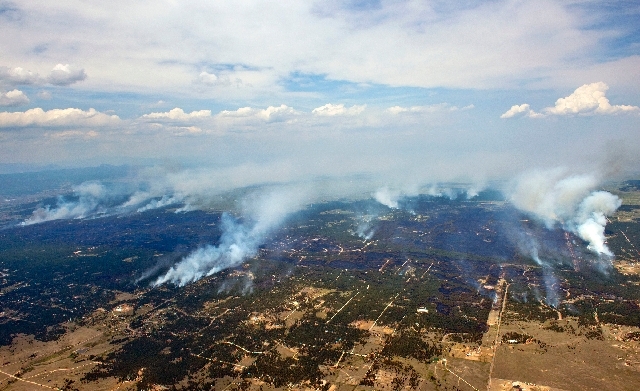Firefighters holding line on Colorado wildfire

COLORADO SPRINGS, Colo. — Firefighters are holding the line on a wildfire near Colorado Springs that has destroyed 379 homes and might have killed two people as they tried to escape.
The fire remained at 25 square miles Friday thanks to lighter winds and firefighters quickly stamping out flare ups. Incident commander Rich Harvey said deputies patrolling for looters helped direct crews to dozens of hot spots.
For the first time since the fire started Tuesday, authorities seem optimistic that they can stop it. Harvey said they were moving toward turning the corner on the fire.
A day after announcing the deaths and record-breaking destruction, El Paso County sheriff Terry Maketa said he was feeling much better about the fire burning in Black Forest, a heavily-wooded area with houses on large lots.
“I thought last night was a success,” said Maketa.
He even made a joke about the weather – encouraging everyone to wash their cars in hopes of raising the chances of rain.
The destruction has surpassed last June’s nearby Waldo Canyon fire as the most destructive in state history. That blaze burned 347 homes and killed two people.
About 38,000 people across roughly 70 square miles have been ordered out of their homes because of the current fire, including residents 1,000 homes within Colorado Springs. Colorado’s second-largest city, with a population of 430,000, also asked residents of 2,000 more homes to be ready to evacuate.
Gene Schwarz, 72, said he never fully unpacked after last year’s fires. He and his neighbors wondered whether grassland to the north of them could be a barrier from the flames.
“It doesn’t matter because a spark can fly over from anywhere,” said Schwarz.
Black Forest, where the blaze began, offers a case study in the challenges of tamping down wildfires across the West, especially with growing populations, rising temperatures and a historic drought.
Developers describe Black Forest as the largest contiguous stretch of ponderosa pine in the United States – a thick, wide carpet of vegetation rolling down from the Rampart Range that thins out to the high grasslands of Colorado’s eastern plains. Once home to rural towns and summer cabins, it is now dotted with million-dollar homes and gated communities – the result of the state’s population boom over the past two decades.
Untold thousands of homes in Colorado’s heavily populated Front Range are at risk for fires, said Gregory Simon, an assistant professor of geography who studies urban wildfires at the University of Colorado-Denver. Many are built on windy mountain roads or cul-de-sacs – appealing to homebuyers seeking privacy but often hampering efforts to stamp out fire. Residents are also attracted by the ability to hike from their backyards and have horses.
“Unfortunately, these environments give the appearance of being peaceful, tranquil and bucolic and natural. But they believe the reality that they are combustible, volatile and at times dangerous,” Simon said.
Nigel Thompson was drawn to Black Forest by the rural feel, privacy, lack of crime and space to raise a family.
“A safe place for my kids to grow up, lots of room for them to run around,” said Thompson, a computer programmer who moved to a house on a 60-acre lot in 1997.
Five years later, he took in evacuees from a devastating fire in the foothills to the northwest. That drove home the fact that his family was living in a tinderbox. Thompson cut down 20 pine trees to form a firebreak around his house, which he topped with fire retardant roof tiles. He diligently cleared away brush, downed branches and pine cones.
“It didn’t make a damn difference at the end of the day,” Thompson said Thursday. His home was incinerated Tuesday.
“If you’re surrounded by people who haven’t done anything, it doesn’t matter what you do,” Thompson said. “It’s interesting that you can have a house in a forest and the building code doesn’t say anything about the roof design.”
That’s what makes fire prevention so difficult, said Anne Walker of the Western Governors’ Association.
“Local government has ultimate authority over where homes are placed,” she said. “You need to look at local ordinances and where homes are placed and what they’re made of.”
El Paso County Commissioner Darryl Glenn said the commission has tried to ensure that new developments have brush clearance and easy emergency access.
“Sometimes it’s just nature,” he said. “When you have a fire like this in a semi-arid environment, there’s not a lot you can do.”
Maketa said firefighters were hampered by a matted layer of pine needles and grass fuel on the forest floor – fuel called “duff.” Spot fires below the trees can smolder for days and even weeks inside it, then blow up. Firefighters see dry matting, Maketa said, “and when you look 10 minutes later, it’s full of flames.”
Other fires burned in Colorado, New Mexico, Oregon and California.
In Canon City, 50 miles southwest of Black Forest, the 5-square-mile Royal Gorge Fire was 20 percent contained. Royal Gorge Bridge & Park officials said that of its 52 buildings, 48 are now gone. The park’s suspension bridge 955 feet above the Arkansas River is still up, though the fire damaged some wooden planks. An aerial tram was destroyed.
A lightning-sparked fire in Rocky Mountain National Park was burning on about 300 acres, less than originally estimated.
—
Associated Press writers Haven Daley and Colleen Slevin contributed to this report.